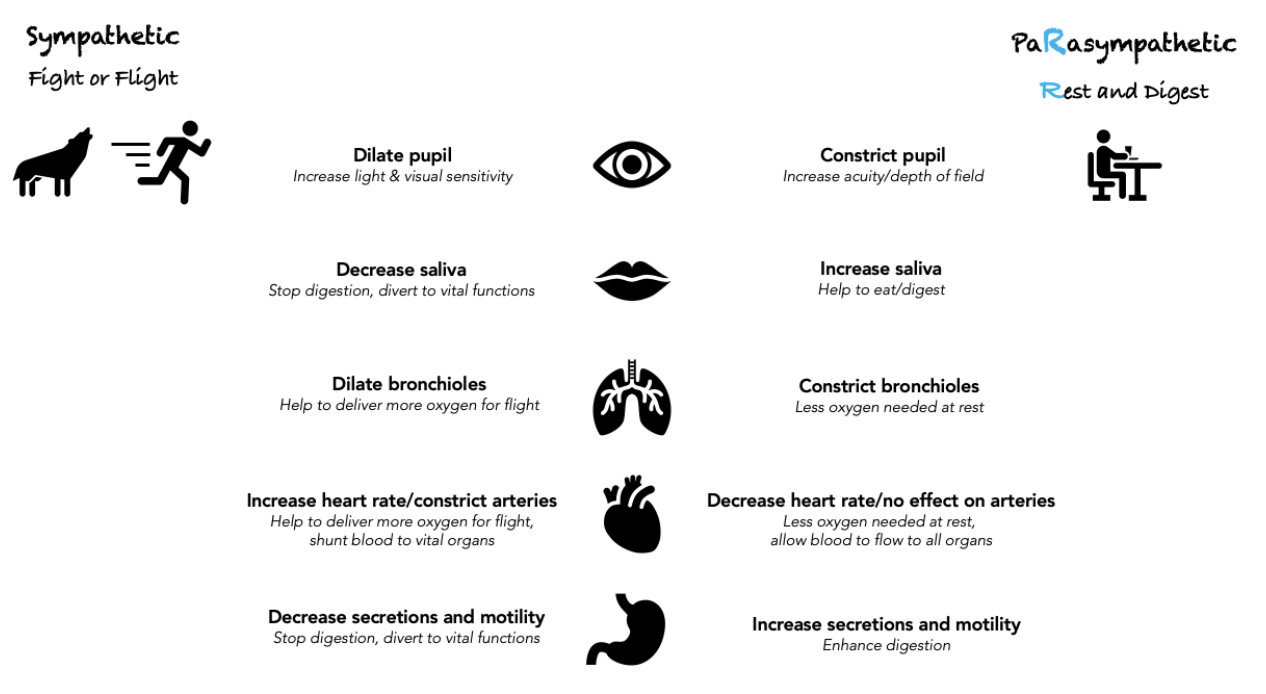The autonomic nervous system is a division of the peripheral nervous system that mediates non-voluntary control of many of the basic functions of the body, such as heart rate, breathing, and digestion. It is made up of the sympathetic and parasympathetic nervous systems, which have opposing functions that help to regulate the body depending on the situation. The sympathetic nervous system is activated by stress and danger and mediates the “fight or flight” response. The parasympathetic nervous system is activated during times of rest to mediate a “rest and digest” response. Below we’ll review the effects and anatomy of each system.
Function
The sympathetic and parasympathetic nervous systems act on many target organs, including the eye, digestive tract, lungs, heart, and bladder, and exert opposing effects that either activate homeostatic functions of the body (parasympathetic, rest and digest) or activate a stress response that helps us survive (sympathetic, fight or flight). The particular effects are outlined in the figure below.

Anatomy and mechanism
Both the sympathetic and parasympathetic nervous systems have a preganglionic neuron with its cell body in the central nervous system and a postganglionic neuron with its cell body in the periphery. The postganglionic neuron then innervates the target organ. The ganglion is where the postganglionic neuron cell body is located (remember that ganglion just means a collection of neuron cell bodies).
The differences between the two systems are related to where the preganglionic neurons are, where the ganglia are located, and what neurotransmitters and receptors are used. The preganglionic neurons of the parasympathetic nervous system are in the brainstem and sacral spinal cord, many of these neurons in the brainstem come together to form the vagus nerve, a large nerve that is responsible for much of the parasympathetic signaling. For the sympathetic nervous system they are located in the thoracic and lumbar spinal cord. The ganglia for the parasympathetic nervous system are located near the end organs, meaning a long preganglionic neuron. The ganglia for the sympathetic nervous system are located close to the spinal cord, meaning a short preganglionic neuron and longer postganglionic neuron. Both preganglionic neurons signal to the postganglionic neuron using acetylcholine and the nicotinic acetylcholine receptor. The parasympathetic postganglionic neuron signals to target organs using acetylcholine sensed by a muscarinic acetylcholine receptor. The sympathetic nervous system on the other hand signals via norepinephrine that binds an adrenergic receptor. These differing neurotransmitters and receptors mediate the different effects of the two systems.

Key points
- The sympathetic nervous system is responsible for the fight or flight response when there is stress or danger. The parasympathetic nervous system mediates more homeostatic function in the rest and digest response (remember paRasympathetic – Rest and digest).
- The sympathetic nervous system has preganglionic neurons in the thoracic and lumbar spinal cord that use acetylcholine as its neurotransmitter. The ganglia are located close to the spinal cord. The postganglionic neuron signals via norepinephrine.
- The parasympathetic nervous system has preganglionic neurons in the brainstem and sacral spinal cord that use acetylcholine as its neurotransmitter. The ganglia are located close to the target tissue. The postganglionic neuron signals via acetycholine (remember pArAsympathetic – uses ACh twice).

Comments